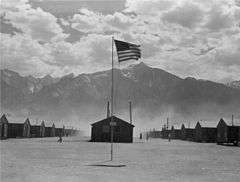Los Angeles Historic-Cultural Monument
Los Angeles Historic-Cultural Monuments are sites in Los Angeles, California, which have been designated by the Los Angeles Cultural Heritage Commission as worthy of preservation based on architectural, historic and cultural criteria.
History
The Historic-Cultural Monument process has its origin in the Historic Buildings Committee formed in 1958 by the Los Angeles chapter of the American Institute of Architects. As growth and development in Los Angeles threatened the city's historic landmarks, the committee sought to implement a formal preservation program in cooperation with local civic, cultural and business organizations and municipal leaders. On April 30, 1962, a historic preservation ordinance proposed by the AIA committee was passed.
The original Cultural Heritage Board (later renamed a commission) was formed in the summer of 1962, consisting of William Woollett, FAIA, Bonnie H. Riedel, Carl S. Dentzel, Senaida Sullivan and Edith Gibbs Vaughan.[1]
The board met for the first time in August 1962, at a time when the owner of the historic Leonis Adobe was attempting to demolish the structure and replace it with a supermarket. In its first day of official business, the board designated the Leonis Adobe and four other sites as Historic-Cultural Monuments.[1][2]
The designation of a property as a Historic-Cultural Monument does not prevent demolition or alteration. However, the designation requires permits for demolition or substantial alteration to be presented to the commission. The commission has the power to delay the demolition of a designated property for up to one year.
In the commission's first decade of operation (August 1962–August 1972), it designated 101 properties as Historic-Cultural Monuments. By March 2010, there were 979 designated properties.[3]
Notable monuments
- Leonis Adobe (HCM #1)
- Bolton Hall (HCM #2) 1913
- Eastern Columbia Building (HCM #294)
- Griffith Park (HCM #942)
- CBS Columbia Square Studios (HCM #947)
Designated LAHCM outside the City of Los Angeles
| HCM #[4] | Landmark name[3] | Image | Date designated[3] | Locality[3] | Area | Description[5] |
|---|---|---|---|---|---|---|
| 160 | Manzanar |  |
September 15, 1976 | Highway 395 36°43′42″N 118°9′16″W / 36.72833°N 118.15444°W |
Inyo County, California | Japanese American internment site, World War II. Located at the foot of the Sierra Nevada in the Owens Valley. Land was owned by the Los Angeles Department of Water and Power when the US Government leased it for the Manzanar concentration camp. |
See also
Lists of L.A. Historic-Cultural Monuments
- Historic-Cultural Monuments in Downtown Los Angeles
- Historic-Cultural Monuments on the East and Northeast Sides
- Historic-Cultural Monuments in the Harbor area
- Historic-Cultural Monuments in Hollywood
- Historic-Cultural Monuments in the San Fernando Valley
- Historic-Cultural Monuments in Silver Lake, Angelino Heights, and Echo Park
- Historic-Cultural Monuments in South Los Angeles
- Historic-Cultural Monuments on the Westside
- Historic-Cultural Monuments in the Wilshire and Westlake areas
Other
- City of Los Angeles' Historic Preservation Overlay Zones
- National Register of Historic Places listings in Los Angeles
- List of California Historical Landmarks
References
- 1 2 Los Angeles Cultural Heritage Commission (July 1994). Historic-Cultural Monuments. City of Los Angeles Cultural Affairs Department.
- ↑ "History of the Cultural Heritage Commission". preservation.lacity.org. Office of Historic Resources, City of Los Angeles. Retrieved August 27, 2013.
- 1 2 3 4 Department of City Planning. "Designated Historic-Cultural Monuments". City of Los Angeles. Retrieved June 15, 2010.
- ↑ Numbers are as designated by the L.A. Historic-Cultural Monuments program. Blue colors represent higher designations as National Historic Landmarks and listing on the National Register of Historic Places; yellow represents sites that are L.A. Historic-Cultural Monuments without a higher designation. No color represents delisted monuments.
- ↑ Various sources cited in articles, retrieved on various dates.
External links
| Wikimedia Commons has media related to Los Angeles Historic-Cultural Monuments. |
- Los Angeles Office of Historic Resources: Designated L.A. Historic-Cultural Monuments (LAHCM) website — with 'ever-updated' LAHCM List via PDF link.
- official Los Angeles Office of Historic Resources website — Homepage
- Los Angeles Cultural Heritage Commission website
- Designated LAHCM Landmarks by Neighborhood — L.A. Department of City Planning website
- Big Orange Landmarks: "Exploring the Landmarks of Los Angeles, One Monument at a Time" — online photos and in-depth history of Los Angeles Historic-Cultural Monuments — Website curator: Floyd B. Bariscale.
- Big Orange Landmarks: Floyd B. Bariscale's Flickr Photostream — Big Orange Flickr Gallery of L.A.H.C.Monuments.